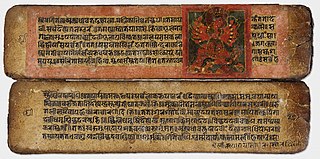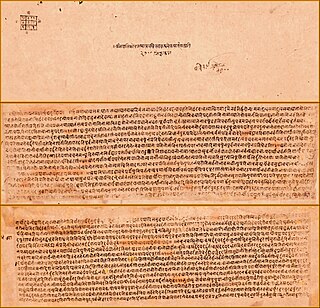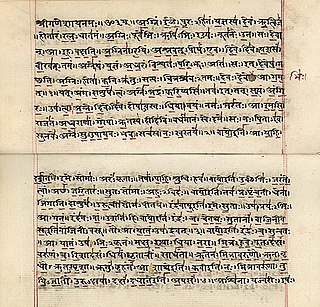
Sutra in Indian literary traditions refers to an aphorism or a collection of aphorisms in the form of a manual or, more broadly, a condensed manual or text. Sutras are a genre of ancient and medieval Indian texts found in Hinduism, Buddhism and Jainism.
A mora is a theoretical or perceptual smallest unit of timing, equal to or shorter than a syllable, in some spoken languages in which phonetic length matters significantly. For example, in the Japanese language, the name of the city Ōsaka (おおさか) consists of three syllables (O-sa-ka) but four morae, since the first syllable, Ō, is pronounced with a long vowel. Thus, a short vowel contains one mora and is called monomoraic, while a long vowel contains two and is called bimoraic. Extra-long syllables with three morae (trimoraic) are relatively rare. Such metrics based on syllables are also referred to as syllable weight. In Japanese, certain consonants also stand on their own as individual morae and thus are monomoraic.
Shloka or śloka (Sanskrit: श्लोक śloka, from the root श्रु śru, lit. 'hear' in a broader sense, according to Monier-Williams's dictionary, is "any verse or stanza; a proverb, saying"; but in particular it refers to the 32-syllable verse, derived from the Vedic anuṣṭubh metre, used in the Bhagavad Gita and many other works of classical Sanskrit literature.

Sanskrit literature is a broad term for all literature composed in Sanskrit. This includes texts composed in the earliest attested descendant of the Proto-Indo-Aryan language known as Vedic Sanskrit, texts in Classical Sanskrit as well as some mixed and non-standard forms of Sanskrit. Literature in the older language begins during the Vedic period with the composition of the Ṛg·veda between about 1500 and 1000 BCE, followed by other Vedic works right up to the time of the grammarian Pāṇini around 6th or 4th century BCE.

The Nāṭya Shāstra is a Sanskrit treatise on the performing arts. The text is attributed to sage Bharata, and its first complete compilation is dated to between 200 BCE and 200 CE, but estimates vary between 500 BCE and 500 CE.
Acharya Pingala was an ancient Indian poet and mathematician, and the author of the Chhandaḥśāstra, also called the Pingala-sutras, the earliest known treatise on Sanskrit prosody.

The Vedas, sometimes collectively called the Veda, are a large body of religious texts originating in ancient India. Composed in Vedic Sanskrit, the texts constitute the oldest layer of Sanskrit literature and the oldest scriptures of Hinduism.
The Vedanga are six auxiliary disciplines of Hinduism that developed in ancient times and have been connected with the study of the Vedas:
The oral tradition of the Vedas consists of several pathas, "recitations" or ways of chanting the Vedic mantras. Such traditions of Vedic chant are often considered the oldest unbroken oral tradition in existence, the fixation of the Vedic texts (samhitas) as preserved dating to roughly the time of Homer.

Nirukta is one of the six ancient Vedangas, or ancillary science connected with the Vedas – the scriptures of Hinduism. Nirukta covers etymology, and is the study concerned with correct interpretation of Sanskrit words in the Vedas.
Shiksha is a Sanskrit word, which means "instruction, lesson, learning, study of skill". It also refers to one of the six Vedangas, or limbs of Vedic studies, on phonetics and phonology in Sanskrit.
Vyākaraṇa refers to one of the six ancient Vedangas, ancillary science connected with the Vedas, which are scriptures in Hinduism. Vyākaraṇa is the study of grammar and linguistic analysis in Sanskrit language.
Vedic metre refers to the poetic metre in the Vedic literature. The study of Vedic metre, along with post-Vedic metre, is part of Chandas, one of the six Vedanga disciplines.
Anuṣṭubh is a metre and a metrical unit, found in both Vedic and Classical Sanskrit poetry, but with significant differences.
Kalpa means "proper, fit" and is one of the six disciplines of the Vedānga, or ancillary science connected with the Vedas – the scriptures of Hinduism. This field of study is focused on the procedures and ceremonies associated with Vedic ritual practice.
Kakawin are long narrative poems composed in Old Javanese, also called "Kawi", written in verse form with rhythms and meters derived from Sanskrit literature. Poets used a formalized literary language, rather than the vernacular. Poets composed and performed the poems at the courts of central and east Java kings between the 9th and 16th centuries, and in Bali.
Āryā metre is a metre used in Sanskrit, Prakrit and Marathi verses. A verse in āryā metre is in four metrical lines called pādas. Unlike the majority of metres employed in classical Sanskrit, the āryā metre is based on the number of mātrās (morae) per pāda. A short syllable counts for one mātrā, and a long syllable counts for two mātrās. It is believed that āryā metre was taken from the gāthā metre of Prakrit. Āryā metre is common in Jain Prakrit texts and hence considered as favourite metre of early authors of Jainism. The earlier form of the āryā metre is called old gīti, which occurs in a some very early Prakrit and Pāli texts.

The Rigveda or Rig Veda is an ancient Indian collection of Vedic Sanskrit hymns (sūktas). It is one of the four sacred canonical Hindu texts (śruti) known as the Vedas. Only one Shakha of the many survive today, namely the Śakalya Shakha. Much of the contents contained in the remaining Shakhas are now lost or are not available in the public forum.
Metrical poetry in Sanskrit is called Chhandas or Chhandas/Chhandassu and Chhandassu. The term Chandas means "pleasing, alluring, lovely, delightful, or charming", and is based on the root chad, which means "esteemed to please, to seem good, feel pleasant, and/or something that nourishes, gratifies, or is celebrated". Chandas refers to the Vedas themselves. Lord Krishna refers to the Vedas as leaves of the tree of creation. Vedas being in verse-form (Chandas), also came to be known as Chandas. The term also refers to "any metrical part of the Vedas or other composition". Prose and poetry follows the rules of Chhandas to design the structural features of 'poetry'. Chhandas is a definable aspect of many definable and indefinable aspects of poetry. Chhandas generates rhythm to the literature when the rules are properly followed. Rhythm is important to literature as a preliminary attraction.








